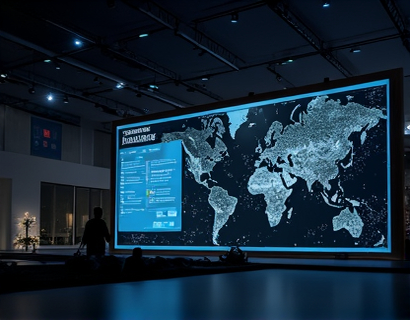Next-Gen QR Code Solutions: Elevating Business Engagement and Social Media Interaction for Modern Enterprises
In the rapidly evolving digital landscape, businesses and social media managers are constantly seeking innovative ways to enhance engagement and interaction with their audience. One such technology that has emerged as a game-changer is the next-generation QR Code, often referred to as enhanced or intelligent QR Codes. These advanced QR Codes are not just a simple upgrade from their traditional counterparts; they offer a suite of features that significantly elevate the way brands connect with consumers and foster deeper, more meaningful interactions.
The evolution of QR Codes into next-gen solutions is driven by the need for more interactive, customizable, and user-friendly tools. Traditional QR Codes, while effective in basic applications, have limitations when it comes to providing rich, dynamic content and seamless user experiences. Next-gen QR Codes address these limitations by integrating advanced technologies such as NFC, augmented reality (AR), and real-time data updates, making them indispensable for modern enterprises looking to stay ahead in the digital race.
Enhanced Content Delivery
One of the primary advantages of next-gen QR Codes is their ability to deliver rich, multimedia content. Unlike standard QR Codes that typically link to a static URL, advanced QR Codes can direct users to interactive web pages, videos, 3D models, and even virtual reality (VR) experiences. This capability allows businesses to create immersive and engaging content that captivates the audience and leaves a lasting impression. For instance, a retail brand can use a next-gen QR Code to showcase a product in 3D, allowing customers to explore its features from all angles before making a purchase decision.
Moreover, next-gen QR Codes can dynamically update their content without the need for physical changes. This means that businesses can refresh the information, promotions, or offers linked to a QR Code in real-time, ensuring that the content remains relevant and appealing. For example, a travel company can use a QR Code that, when scanned, directs users to the latest deals and packages, providing a personalized and up-to-date experience.
Customization and Branding
Customization is another key feature of next-gen QR Codes. Brands can design QR Codes that match their visual identity, incorporating their logos, colors, and branding elements. This level of personalization not only enhances the aesthetic appeal but also reinforces brand recognition and trust. When a customer scans a QR Code that aligns with the brand's visual language, it creates a cohesive and professional experience that can significantly impact perception and loyalty.
Furthermore, next-gen QR Codes can be designed with interactive elements such as animations, buttons, and forms. These features allow brands to guide users through a specific journey, from scanning the code to completing a purchase, signing up for a newsletter, or providing feedback. For instance, a tech company can create a QR Code that, when scanned, presents a series of interactive steps to install a new app, complete with step-by-step instructions and visual aids.
Improved User Experience
The user experience is paramount in today's digital interactions, and next-gen QR Codes are designed to optimize this aspect. With advanced QR Codes, the process of scanning and accessing content is faster and more intuitive. Many next-gen solutions incorporate error correction codes and adaptive scanning technologies that ensure the QR Code is readable and functional even in challenging environments, such as low light or when partially obscured.
Additionally, next-gen QR Codes can be integrated with mobile apps and other digital platforms, providing a seamless transition from the physical to the digital world. For example, a museum can use a QR Code that, when scanned, not only provides information about an exhibit but also offers an augmented reality experience that brings the exhibit to life. This integrated approach enhances the visitor's experience and encourages longer engagement with the content.
Boosting Social Media Interaction
Social media platforms are a critical channel for businesses to engage with their audience, and next-gen QR Codes can significantly enhance this interaction. By placing QR Codes in physical locations or on printed materials, businesses can drive traffic to their social media profiles, campaigns, or events. When users scan these QR Codes, they are instantly directed to the desired social media content, making it easier for them to follow, like, share, and engage with the brand.
Moreover, next-gen QR Codes can be used to create unique and shareable experiences that encourage social media sharing. For instance, a fashion brand can create a QR Code that, when scanned, generates a personalized outfit recommendation based on the user's preferences. The user can then share this personalized look on their social media, effectively becoming a brand ambassador and increasing organic reach and engagement.
Another innovative use case is the integration of QR Codes with social media contests and challenges. A brand can create a QR Code that, when scanned, directs users to a landing page where they can enter a contest or participate in a challenge. This not only boosts engagement but also provides valuable user-generated content that can be repurposed for marketing purposes.
Enhancing Customer Service and Feedback
Next-gen QR Codes can also play a significant role in improving customer service and gathering valuable feedback. By including a QR Code on product packaging, receipts, or in-store displays, businesses can direct customers to a feedback form or a support portal. This makes it convenient for customers to provide input or seek assistance, leading to better customer satisfaction and more actionable insights for the business.
Furthermore, QR Codes can be used to offer exclusive discounts or rewards to customers who scan and provide feedback. This incentivizes customers to engage with the brand and share their experiences, fostering a loyal community. For example, a restaurant can place a QR Code on the table that, when scanned, allows customers to rate their meal and enter a draw for a free dessert. The feedback collected can help the restaurant improve its services and menu offerings.
Data Collection and Analytics
One of the most powerful aspects of next-gen QR Codes is their ability to collect and analyze data. Each scan can be tracked and recorded, providing businesses with valuable insights into customer behavior, preferences, and engagement patterns. This data can be used to optimize marketing strategies, refine product offerings, and personalize customer interactions.
For instance, a retail store can use QR Codes to track which products are most frequently scanned, indicating high interest and potential sales opportunities. This information can inform inventory decisions and targeted marketing campaigns. Additionally, by analyzing scan data over time, businesses can identify trends and make data-driven decisions to enhance the overall customer experience.
Security and Authenticity
Security is a critical concern in today's digital world, and next-gen QR Codes offer advanced features to ensure the authenticity and integrity of the content they link to. By incorporating security tokens and encryption, these QR Codes can prevent unauthorized access and protect sensitive information. This is particularly important for businesses handling financial transactions or personal data.
For example, a financial institution can use a next-gen QR Code to link to a secure login page, ensuring that users are directed to a verified and secure environment. This not only enhances security but also builds trust with customers who are increasingly wary of online fraud.
Case Studies and Real-World Applications
To better understand the impact of next-gen QR Codes, let's explore a few real-world applications across different industries.
In the retail sector, a major clothing brand implemented next-gen QR Codes on its product tags. When customers scan these codes, they are directed to a virtual try-on feature that uses AR to show how the garment would look without the need to physically change clothes. This not only enhances the shopping experience but also reduces return rates by helping customers make more informed decisions.
In the travel industry, a hotel chain used QR Codes on their welcome cards to provide guests with a seamless check-in experience. By scanning the code, guests can access their room keys, hotel information, and local attractions, all in one place. This streamlined process has significantly improved guest satisfaction and loyalty.
In the education sector, a university utilized next-gen QR Codes on campus maps to offer students and visitors an interactive tour. Scanning the code at different locations triggers audio guides, historical facts, and navigation assistance, enriching the visitor's experience and providing educational value.
Conclusion
Next-gen QR Codes represent a significant advancement in the way businesses and brands interact with their audience. By offering enhanced content delivery, customization options, improved user experiences, and robust data collection capabilities, these advanced QR Codes are becoming an essential tool for modern enterprises. As the digital landscape continues to evolve, embracing next-gen QR Code solutions will be crucial for brands looking to stay competitive, engage more deeply with their audience, and drive meaningful business outcomes.










































